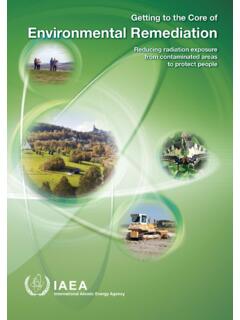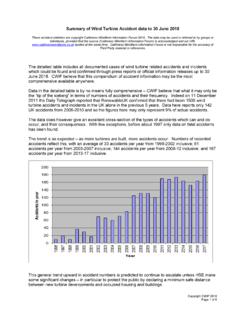Transcription of Nuclear Disaster at Chernobyl
1 Knowledge Article: World Geography 1 Nuclear Disaster at Chernobyl The Setting In the years following World War II, the United States Nuclear monopoly quickly disappeared. Several industrialized countries, including France, Great Britain, and the Soviet Union, all gained access to Nuclear technology. In the context of the Cold War, Nuclear technology was extremely important because it could be used to create powerful weapons. In fact, a single Nuclear weapon can destroy an entire city. During World War II, the United States became the first nation to use a Nuclear weapon. Although the United States, Soviet Union, and other nations developed thousands of Nuclear weapons during the Cold War, these nations also adapted Nuclear technology to civilian and commercial use in the form of Nuclear fission power. Over time, many countries built Nuclear power plants. Today, Nuclear energy continues to power everything from aircraft carriers and submarines to traffic lights and households.
2 During the Cold War, the Soviet government built Nuclear power plants throughout the country to supply electricity to millions of citizens. However, unlike the Nuclear power plants built in the United States and elsewhere, Soviet Nuclear facilities often did not include important safety features, such as a Nuclear containment dome. One such Soviet Nuclear plant was located in the Ukraine, about 80 miles north of Kiev, its capital city. Now commonly referred to simply as " Chernobyl ," this Nuclear power plant has become the site of the most devastating Nuclear Disaster in history. 2 The Accident On April 25, 1986, workers at the Chernobyl Nuclear power plant initiated a series of tests on one of its Nuclear reactors. These tests were thought to be a safe and routine check of how the reactor would perform under a loss of external power. However, the tests went horribly wrong, and the reactor's temperature soon rose to a dangerous level. This was the result of a flawed plant design as well as inadequately trained workers making numerous errors and ignoring safety warnings.
3 Despite a last-minute attempt to solve the problem, the reactor exploded on the morning of April 26, 1986. This first explosion was quickly followed by a larger, second blast that released radioactive material into the atmosphere and also ignited a graphite fire that took nine days to extinguish. Following the explosion, many plant workers and emergency responders were exposed to radiation. Local firefighters called to the scene received fatal amounts of radiation exposure as they attempted to put out the fires. Many of them died within weeks. In a desperate attempt to slow down the fire and prevent more radiation from escaping, Soviet officials directed helicopters to drop roughly 5,000 tons of sand, clay, and other materials on the reactor. When this mission failed, the reactors were resealed. Construction of a concrete enclosure around the site soon began, but it took months to complete. The Cover-Up The Soviet government initially tried to hide the Disaster from its citizens and the outside world.
4 However, evidence of the Disaster soon spread. Radioactive materials were not just deposited around Chernobyl and the Ukraine, but nearby Soviet republics such as Belarus and Russia were also becoming contaminated as winds carried radioactive elements from the site. Soon areas as far away as Europe and North America were detecting higher levels of radiation in the air. Workers at a Swedish Nuclear power plant were the first to suspect that a Nuclear accident had occurred. On April 28, two days after the explosions, technicians at the Forsmark Nuclear Power Plant, 60 miles north of Stockholm, noticed abnormally high levels of radiation, which the workers initially thought indicated an accident at their own plant. After careful investigation, however, they realized that their reactors were working properly. Workers at Forsmark deduced that a Nuclear Disaster probably happened somewhere in the Soviet Union, with winds bringing the radioactive material in their direction. When Sweden and other countries demanded an explanation from Moscow, they were met with denial and silence from the Soviet government.
5 Then, on the evening of April 28, the Soviet government released a brief statement about the incident: 3 An accident has taken place at the Chernobyl power station, and one of the reactors was damaged. Measures are being taken to eliminate the consequences of the accident. Those affected by it are being given assistance. A government commission has been set up. Soviet-controlled state media was doing its best to prevent information about the accident from coming to light. However, evidence gathered from Western satellite photos let the rest of the world know it was a far more dangerous situation than Moscow was letting on. All evidence pointed to a Nuclear reactor fire burning out of control in the Ukraine. Despite a lack of information, the international community offered its assistance. The Soviets declined. European governments urged their citizens to stay inside and avoid buying milk or fresh vegetables since those products could be radioactively contaminated.
6 Many Western governments also arranged for their citizens staying in the Soviet Union to be airlifted out of the danger zone. Soviet citizens were also kept in the dark about the situation. Within the first few days after the Disaster , many Soviet people went on as if nothing had happened. For example, there were reports of schoolchildren cheering on the first firefighters as they attempted to put out the flames. As the days passed, most of the news that the Soviet people received was leaked from Western media. Regardless, life continued largely uninterrupted. Children still attended school, and adults still went to work. Results of the Disaster Environment and People Weeks after the incident, the Soviet government began to realize the extent of the Disaster . The local ecosystem was inundated with radioactive materials. The removal of contaminated trees and topsoil soon became a top priority. Over time, such radiation contamination would harm humans through food consumption.
7 In 1986 and 1987 alone, more than 200,000 Soviet workers were called to help clean up the area. Radiation poisoning can cause many maladies, including cancer and birth defects. In the months after the Chernobyl explosions, at least 30 people died from radiation poisoning. Plant workers and firefighters were among the most vulnerable. It was feared that thousands more could eventually die as a result of cancer due to radiation exposure. Nearly a week after the Disaster , the Soviet government began evacuating the 45,000 residents who lived within a 10-kilometer radius of the Chernobyl plant. Included in this evacuation zone was the town of Prypiat, where most of the plant's workers lived. Two days later, those within 30 kilometers were evacuated. In all, the two evacuations displaced roughly 150,000 people from their homes. 4 It s still unclear what health effects may have resulted from the Disaster . According to the World health Organization, as many as 3,000 people have already died from the effects of radiation exposure at Chernobyl .
8 Many reports, however, claim that there will be thousands more victims in the coming years. Economy Today, there remains a 30-kilometer exclusion zone around the plant. Officially, nobody is allowed to resettle in the area, although some have. This exclusion zone is damaging to Ukraine's people and economy because this region once contained some of the most productive farmland in the area. The other reactors at the Chernobyl plant remained online through the year 2000 despite the accident and lingering radiation. However, this continued operation was not cheap. It is estimated that more than $400 million was invested into the Chernobyl plant after the accident to implement new safety measures. Even though the plant is no longer in operation today, more work is needed at the site because the containment structure built over the damaged reactor is in need of replacement. If left alone, natural weathering could expose more radiation to the environment. Because Ukraine is cash-strapped, it has requested the aid of foreign governments to assist in this project.
9 However, funding has been slow to arrive. Sources Bleickardt, Peter, Steven Quirk, and Bill Beegle. Fighting the Fire. Chernobyl : A Nuclear Disaster . Chernobyl : The True Scale of the Accident. World health Organization, Sept. 5, 2005. Frequently Asked Chernobyl Questions. International Atomic Energy Agency, April 26, 2011. Poberezhska, Lily. In the Dark, IEAE Bulletin, Vol. 47, No. 2. International Atomic Energy Agency.




